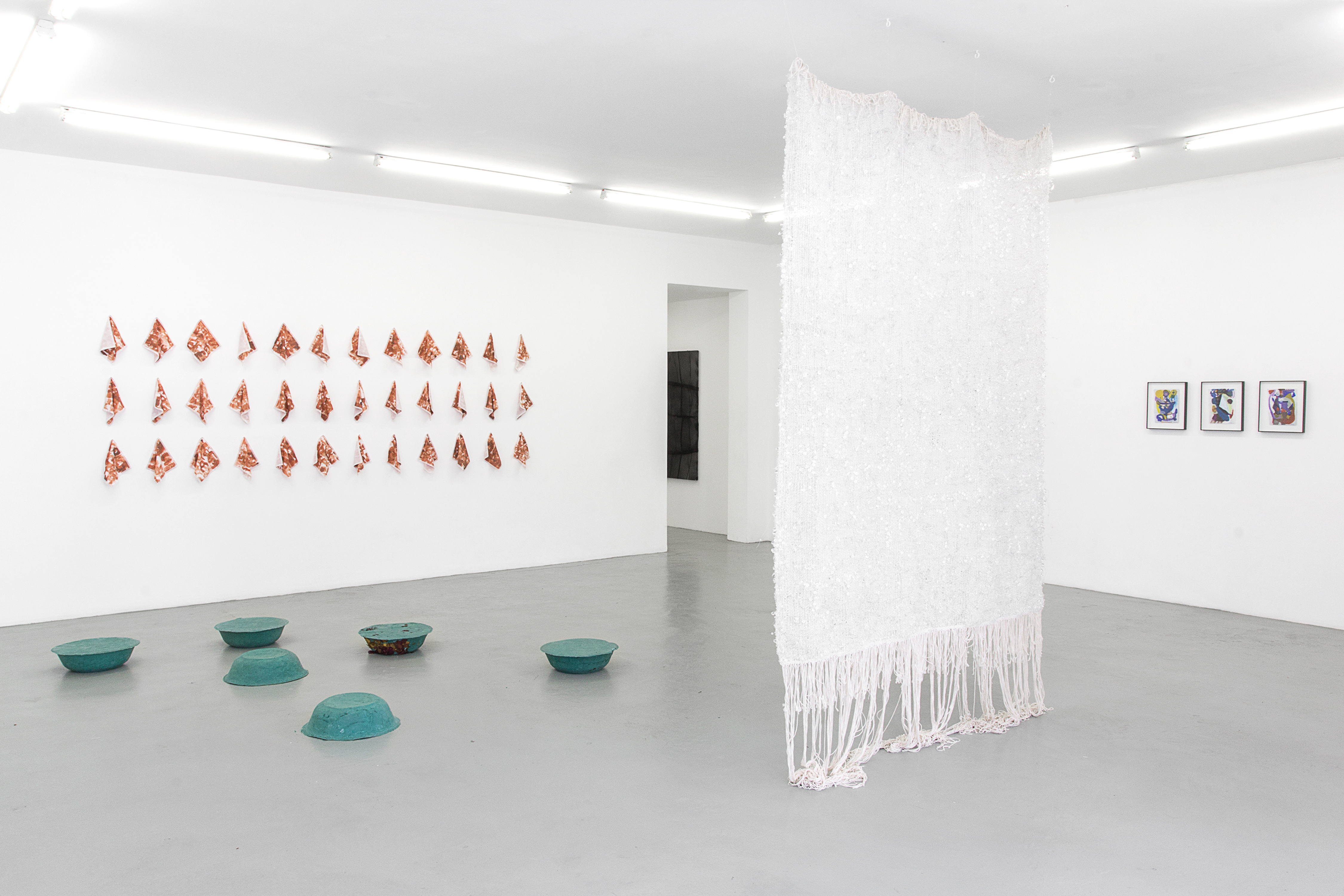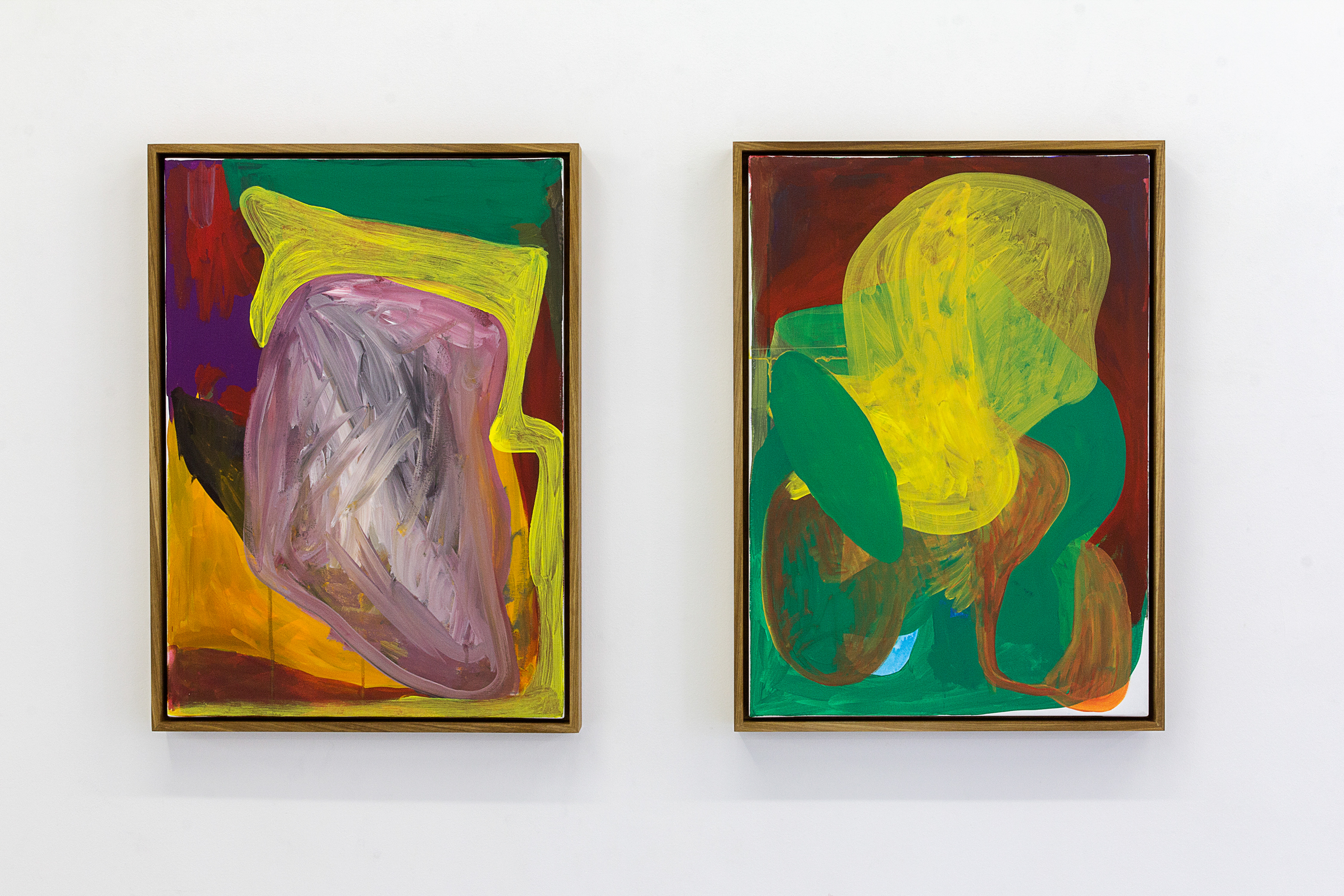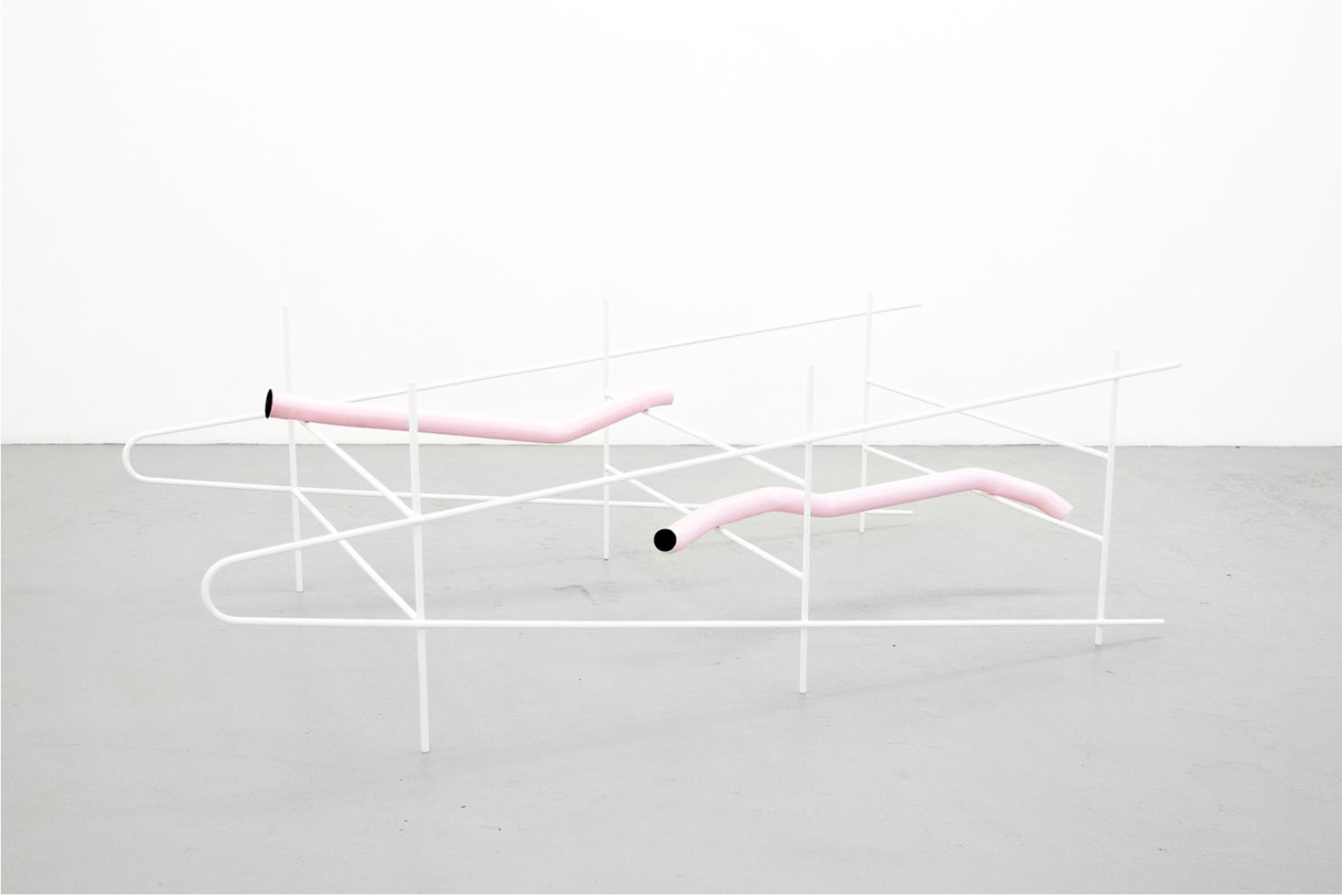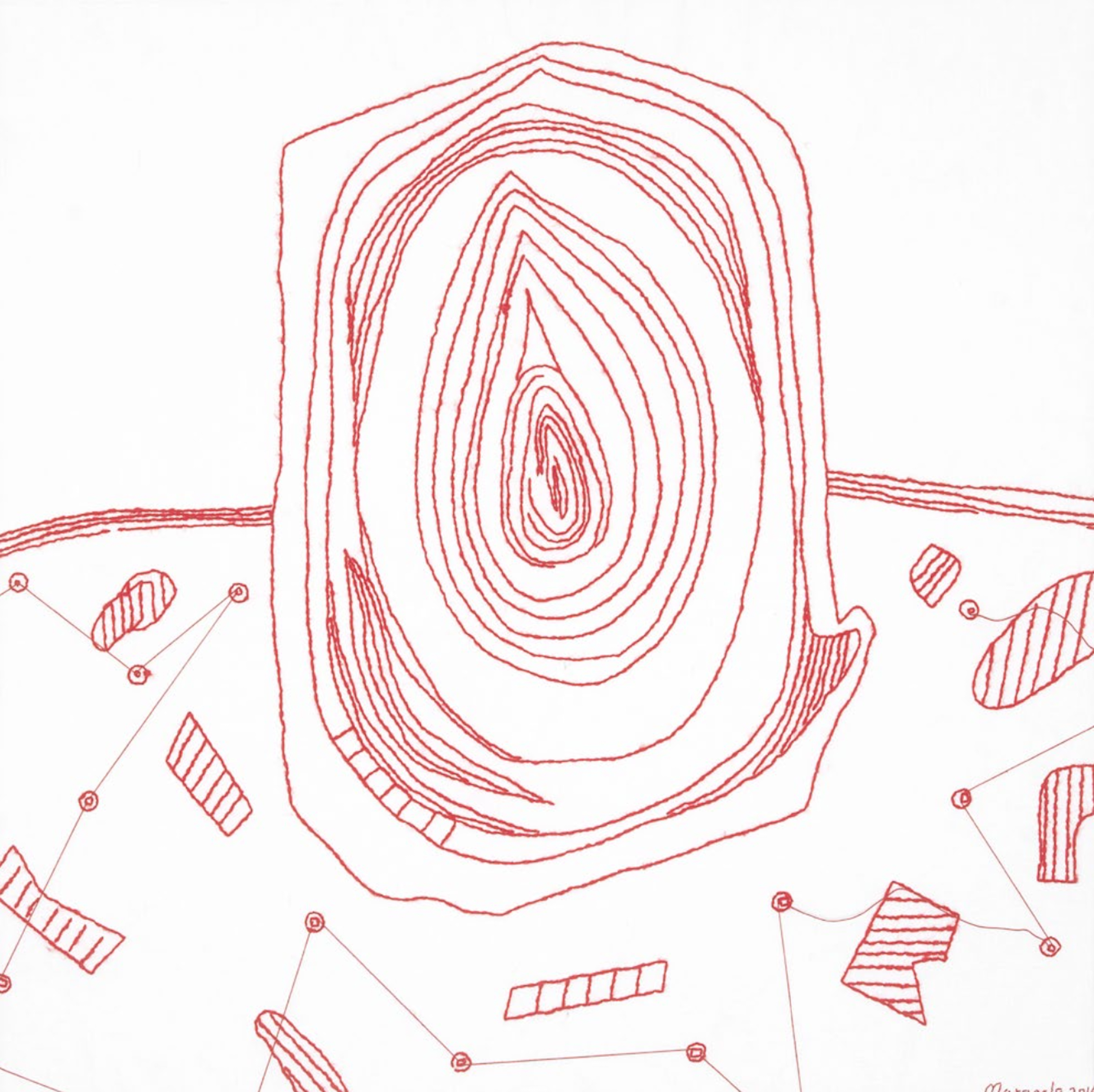












The exhibition considers the ways in which the ‘figure’ manifests in the work of these artists, defined either as the representation of a body, or as a numeral, a diagram or a geometric form. Starting with this as a curatorial proposition, Figure attempts to weave together the work of artists from twelve distinct positions. The result is a loose topography that reflects on our time and place, with such diverse concerns as memory, the politicised body and formal abstraction.
A reoccurring theme in the exhibition is that of remembrance and memorialisation. Through the use of found objects and mark-making, personal and collective histories are traced and recorded in artworks that range from the conceptual to the representational.
—
Senzeni Marasela’s six-year project Ijeremani Lam relates a story of Marasela’s alter-ego, Theodorah, in which she searches Johannesburg for her husband Gebane Mthetyane. In Last Seen, a red wool embroidery on canvas, Theodorah relies for guidance on the memories of people who may have seen him last. The character of Theodorah is based on the artist’s own mother and her traumatizing experience of the migrant labour system, that saw the destruction of rural families and desertion of black women throughout rural South Africa. Marasela has realized Theodorah in various mediums including performance, video, print and embroidery. Similarly, Cinga Samson pays homage to his mother, Sis Lungy, in Hliso Street, a new series of portraits. The paintings are intended as a letter to Sis Lungy, who died from AIDS-related illness in 2003. Samson describes the works as a celebration of his youth as well as marking a new chapter in his life: “With them I also remember my mother’s aspirations for me and her instructions… this is my way of speaking to this disease that ruins our lives, especially in townships and rural areas”.
Comprising of several small items including a plastic bottle, condom, clock hand and a miniature model of a Native American head, is a 2014 assemblage by the French-Martinican artist Julien Creuzet, titled, I feel like a black hole, drawing in the slightest spark. A blue abyss, den of the sea, at the end of the pontoon of Pointe Lamar. Do I look like I have severe facial injuries? They didn’t want to sell me any stellite. I need to say, to unlock my jaw, to place it on top of the coke bottle. My makeshift dentures, brass alloy. What is in there, everything I see in myself, I am this condom filled with caffeine. The same ochre powder I put in my jeans. Him, inside, a turd covered in bubbles, my sex lying underwater in the plastic bottle (…)
About Creuzet’s use of found objects, the curator and critic Dorothée Dupuis writes: “Even when [the objects] appear as themselves in the work, they are always this but also something else, and Creuzet is very careful to never lock their meaning. On the contrary, the idea is to grant these objects new properties and histories through their apparition into an artistic narrative. […] To modify the narratives contained in charged objects, especially the ones loaded with controversial connotations linked to problematic moments of human history such as the colonial era, draws the possibility for historically exploited populations to reestablish a neutral relationship to these objects and thus, their own history, through imagination and poetry.” (Dupuis, As told by my obsidian head in ‘Terremoto: Contemporary Art in the Americas’, published online May 2015)
Donna Kukama’s 364 and still counting… is a handwritten layering of numbers from 1 to 364, written in Khoekhoe and Setswana. A re-counting of the number of years since the arrival of Europeans in Cape Town in 1652, 364 and still counting… also becomes a physical trace of a violent act. Presented as a series of digital prints on handkerchiefs, the work is a miniature monument originally written with soil, sweat, and blood. Focused in a different way on the reading of bodily remnants and traces is Bronwyn Katz’s Blommetjies. Made from salvaged mattress and wire, the wall-based sculpture is a continuation of the artist’s ongoing research. In this work, the title of which translates as ‘little flowers’, the soiled surface of the mattress foam is embedded with the residue of bed springs and bears semblance to a landscape, while evoking the memory of the bodies that have occupied it.
In Lumka, artist and sangoma (traditional healer) Buhlebezwe Siwani draws on her childhood memories of being washed by her aunt and grandmother in public. Employing as her medium the ubiquitous green detergent soap that her relatives used to wash her, Siwani brings to light the ‘duplicitous’ nature of the soap, which is both a symbol of cleanliness (feminine hygiene) and a harsh chemical cleanser that can cause painful skin reactions. In this work, the purpose of the soap is inverted: intended for erasure or removal, the bar soap is now an essential material with which Siwani creates her work.
While Siwani’s work is informed by memory and personal experience, it also evokes concepts of body gendering and prescriptions of femininity. These themes are also present in the abstract fabric works of Scheepers and Magadlela, which suggest the physicality of the body through their materiality and form.
Fat Swan Lake continues Turiya Magadlela’s series of stretched and stitched pantyhose works. The repetition of the crotch seams – in places puckered, folded, or torn – alludes to female genitalia, and is simultaneously suggestive of sexual intimacy and sexual violence. As with Magadlela’s I never made Swan Lake works, the title Fat Swan Lake refers to the standard of feminine beauty – defined by whiteness and thinness – as being best exemplified in the ballerina figure. Implied by the title and the use of black stockings, the work becomes a projection of an ‘inferior’ or alienated femininity. More explicit in its reference to the body, Gerda Scheepers’ 62 A/B (1) is the unmistakable, though gender neutral, study of a torso. Constructed using flesh-toned t-shirt material stretched over bra cups, the work is at once minimal and precise. Framed in timber painted the same hue as the ‘picture plane’, the monochromatic composition only gestures towards figuration by means of the invisible volumes hidden beneath the canvas. According to Scheepers, the work is essentially abstract, but “built with familiarities, like body issues and daily life issues”.
Included in the exhibition is a selection from a series of untitled mixed media paintings by Norway-based Namibian artist Herman Mbamba, done on the torn out pages of a Norwegian magazine in a combination of acrylic, gouache, pen and pencil. Mbamba states: “In using magazine cut outs as the painterly surface, I simply enter into dialogue with existing elements on the surface; such as colour compositions, socio-cultural references or texts.” In this way, the works are hybrid: they deal with the formal language of painting while conceptually, they “dwell in the socio-cultural or economical framework of [Mbamba’s] existence” – that of living in the diaspora.
Shifting towards an understanding of the ‘figure’ in abstract terms – such as a shape, motif or diagram – is a new tapestry by Igshaan Adams. Rendered in the geometric style of Arabic calligraphy known as square Kufic, Ayatul Kursi (Verse of the Throne) is a depiction of the most popular verse in the Qur’an. The verse, which describes the absolute power of God, is believed by some to be a protective prayer that wards off bad spirits, and is commonly recited before sleep. Woven out of clear beads and string, the tapestry is reflective and translucent, lending it an ephemerality uncommon in Adams’ recent works. Also on exhibition are two new sculptural pieces by Jared Ginsburg and Kyle Morland. Operated using a system of ropes, Ginsburg’s Curtain 2 (prototype) is the aptly named defunct prototype of the second or ‘false proscenium’ curtain made for the forthcoming performance titled Interludes, to be presented in 2017. The second curtain is an essential part of the theatre structure, functioning to conceal scene changes as well as to control the reveal of new scenes. Originally conceived for his recent solo exhibition Assemble, Kyle Morland’s contribution to the exhibition is an assemblage of found steel pipes, which the artist has cut up and manipulated.
Through the lens of this exhibition, parallels can be drawn between the artists’ differing approaches to the ‘figure’, each uniquely determined by their backgrounds and processes, though linked together by a shared focus on materiality.
A reoccurring theme in the exhibition is that of remembrance and memorialisation. Through the use of found objects and mark-making, personal and collective histories are traced and recorded in artworks that range from the conceptual to the representational.
—
Senzeni Marasela’s six-year project Ijeremani Lam relates a story of Marasela’s alter-ego, Theodorah, in which she searches Johannesburg for her husband Gebane Mthetyane. In Last Seen, a red wool embroidery on canvas, Theodorah relies for guidance on the memories of people who may have seen him last. The character of Theodorah is based on the artist’s own mother and her traumatizing experience of the migrant labour system, that saw the destruction of rural families and desertion of black women throughout rural South Africa. Marasela has realized Theodorah in various mediums including performance, video, print and embroidery. Similarly, Cinga Samson pays homage to his mother, Sis Lungy, in Hliso Street, a new series of portraits. The paintings are intended as a letter to Sis Lungy, who died from AIDS-related illness in 2003. Samson describes the works as a celebration of his youth as well as marking a new chapter in his life: “With them I also remember my mother’s aspirations for me and her instructions… this is my way of speaking to this disease that ruins our lives, especially in townships and rural areas”.
Comprising of several small items including a plastic bottle, condom, clock hand and a miniature model of a Native American head, is a 2014 assemblage by the French-Martinican artist Julien Creuzet, titled, I feel like a black hole, drawing in the slightest spark. A blue abyss, den of the sea, at the end of the pontoon of Pointe Lamar. Do I look like I have severe facial injuries? They didn’t want to sell me any stellite. I need to say, to unlock my jaw, to place it on top of the coke bottle. My makeshift dentures, brass alloy. What is in there, everything I see in myself, I am this condom filled with caffeine. The same ochre powder I put in my jeans. Him, inside, a turd covered in bubbles, my sex lying underwater in the plastic bottle (…)
About Creuzet’s use of found objects, the curator and critic Dorothée Dupuis writes: “Even when [the objects] appear as themselves in the work, they are always this but also something else, and Creuzet is very careful to never lock their meaning. On the contrary, the idea is to grant these objects new properties and histories through their apparition into an artistic narrative. […] To modify the narratives contained in charged objects, especially the ones loaded with controversial connotations linked to problematic moments of human history such as the colonial era, draws the possibility for historically exploited populations to reestablish a neutral relationship to these objects and thus, their own history, through imagination and poetry.” (Dupuis, As told by my obsidian head in ‘Terremoto: Contemporary Art in the Americas’, published online May 2015)
Donna Kukama’s 364 and still counting… is a handwritten layering of numbers from 1 to 364, written in Khoekhoe and Setswana. A re-counting of the number of years since the arrival of Europeans in Cape Town in 1652, 364 and still counting… also becomes a physical trace of a violent act. Presented as a series of digital prints on handkerchiefs, the work is a miniature monument originally written with soil, sweat, and blood. Focused in a different way on the reading of bodily remnants and traces is Bronwyn Katz’s Blommetjies. Made from salvaged mattress and wire, the wall-based sculpture is a continuation of the artist’s ongoing research. In this work, the title of which translates as ‘little flowers’, the soiled surface of the mattress foam is embedded with the residue of bed springs and bears semblance to a landscape, while evoking the memory of the bodies that have occupied it.
In Lumka, artist and sangoma (traditional healer) Buhlebezwe Siwani draws on her childhood memories of being washed by her aunt and grandmother in public. Employing as her medium the ubiquitous green detergent soap that her relatives used to wash her, Siwani brings to light the ‘duplicitous’ nature of the soap, which is both a symbol of cleanliness (feminine hygiene) and a harsh chemical cleanser that can cause painful skin reactions. In this work, the purpose of the soap is inverted: intended for erasure or removal, the bar soap is now an essential material with which Siwani creates her work.
While Siwani’s work is informed by memory and personal experience, it also evokes concepts of body gendering and prescriptions of femininity. These themes are also present in the abstract fabric works of Scheepers and Magadlela, which suggest the physicality of the body through their materiality and form.
Fat Swan Lake continues Turiya Magadlela’s series of stretched and stitched pantyhose works. The repetition of the crotch seams – in places puckered, folded, or torn – alludes to female genitalia, and is simultaneously suggestive of sexual intimacy and sexual violence. As with Magadlela’s I never made Swan Lake works, the title Fat Swan Lake refers to the standard of feminine beauty – defined by whiteness and thinness – as being best exemplified in the ballerina figure. Implied by the title and the use of black stockings, the work becomes a projection of an ‘inferior’ or alienated femininity. More explicit in its reference to the body, Gerda Scheepers’ 62 A/B (1) is the unmistakable, though gender neutral, study of a torso. Constructed using flesh-toned t-shirt material stretched over bra cups, the work is at once minimal and precise. Framed in timber painted the same hue as the ‘picture plane’, the monochromatic composition only gestures towards figuration by means of the invisible volumes hidden beneath the canvas. According to Scheepers, the work is essentially abstract, but “built with familiarities, like body issues and daily life issues”.
Included in the exhibition is a selection from a series of untitled mixed media paintings by Norway-based Namibian artist Herman Mbamba, done on the torn out pages of a Norwegian magazine in a combination of acrylic, gouache, pen and pencil. Mbamba states: “In using magazine cut outs as the painterly surface, I simply enter into dialogue with existing elements on the surface; such as colour compositions, socio-cultural references or texts.” In this way, the works are hybrid: they deal with the formal language of painting while conceptually, they “dwell in the socio-cultural or economical framework of [Mbamba’s] existence” – that of living in the diaspora.
Shifting towards an understanding of the ‘figure’ in abstract terms – such as a shape, motif or diagram – is a new tapestry by Igshaan Adams. Rendered in the geometric style of Arabic calligraphy known as square Kufic, Ayatul Kursi (Verse of the Throne) is a depiction of the most popular verse in the Qur’an. The verse, which describes the absolute power of God, is believed by some to be a protective prayer that wards off bad spirits, and is commonly recited before sleep. Woven out of clear beads and string, the tapestry is reflective and translucent, lending it an ephemerality uncommon in Adams’ recent works. Also on exhibition are two new sculptural pieces by Jared Ginsburg and Kyle Morland. Operated using a system of ropes, Ginsburg’s Curtain 2 (prototype) is the aptly named defunct prototype of the second or ‘false proscenium’ curtain made for the forthcoming performance titled Interludes, to be presented in 2017. The second curtain is an essential part of the theatre structure, functioning to conceal scene changes as well as to control the reveal of new scenes. Originally conceived for his recent solo exhibition Assemble, Kyle Morland’s contribution to the exhibition is an assemblage of found steel pipes, which the artist has cut up and manipulated.
Through the lens of this exhibition, parallels can be drawn between the artists’ differing approaches to the ‘figure’, each uniquely determined by their backgrounds and processes, though linked together by a shared focus on materiality.